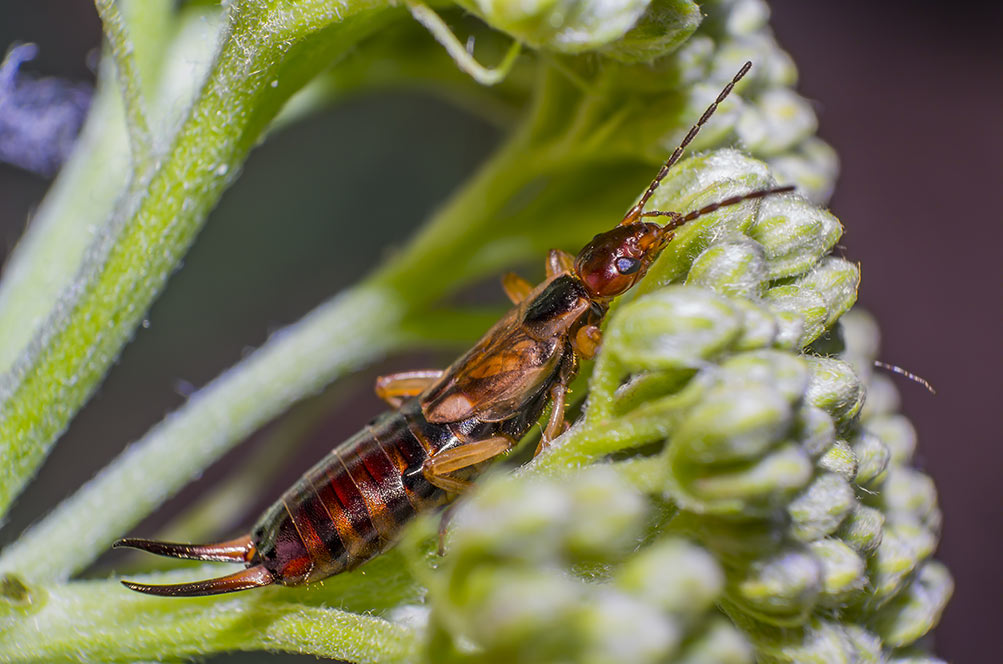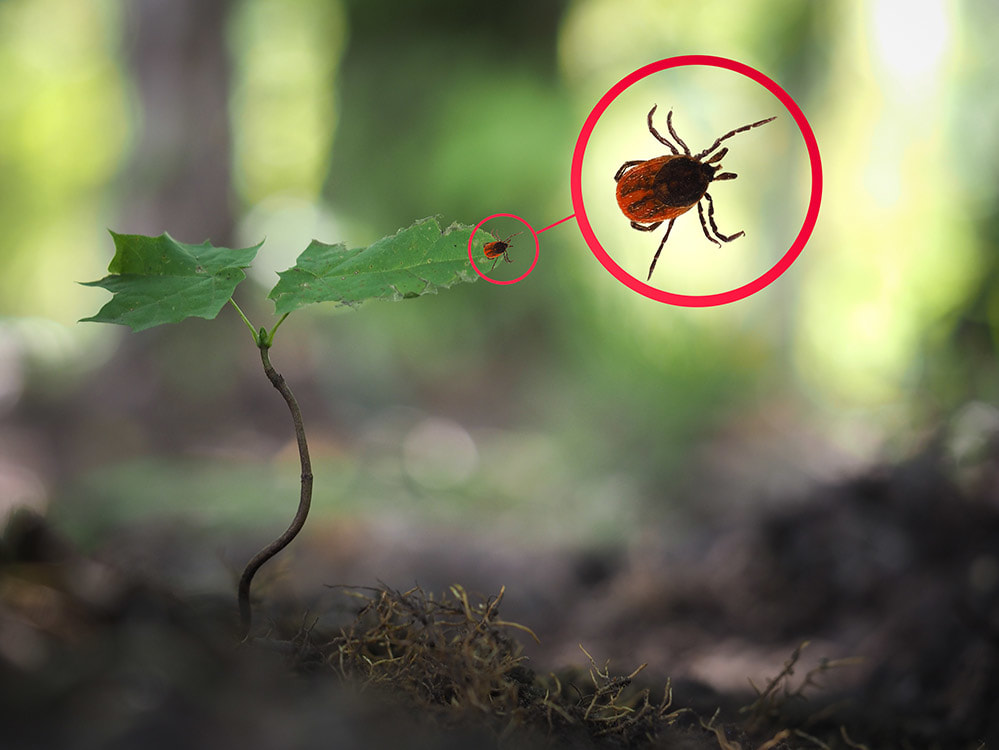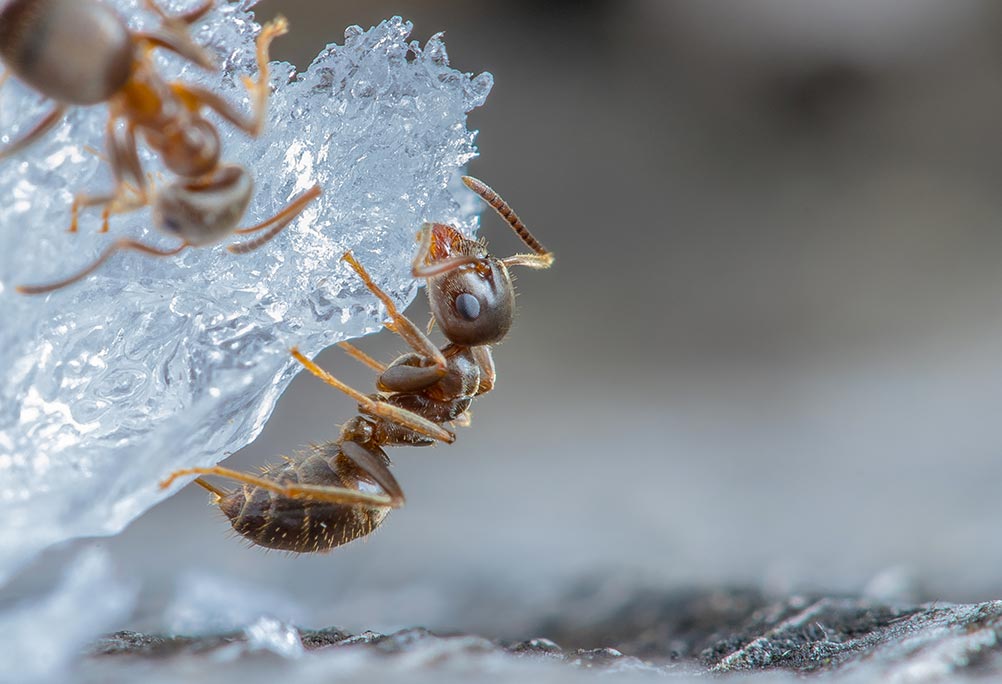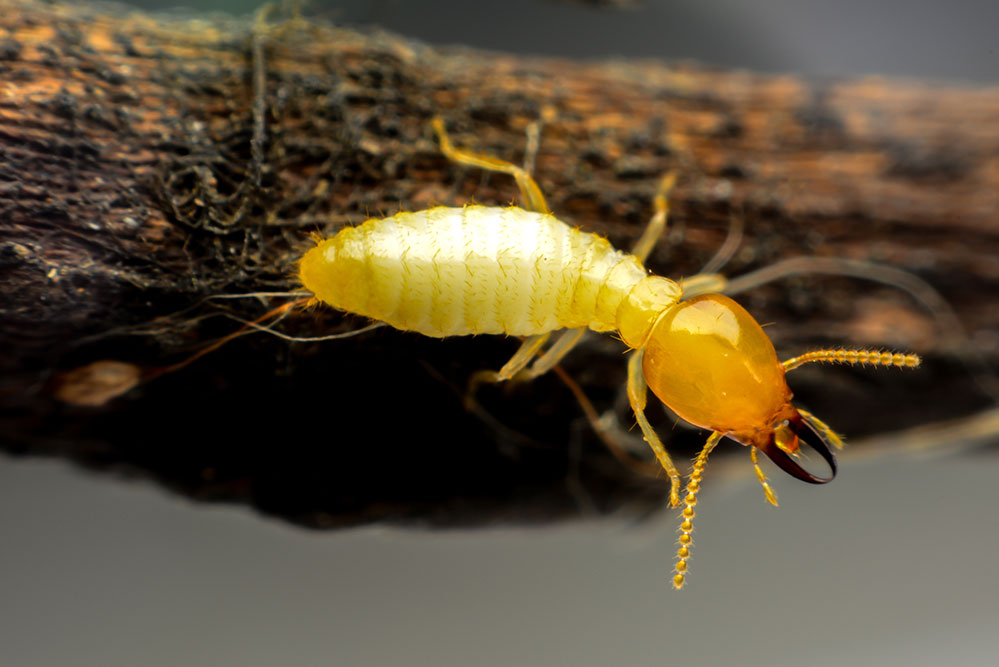|
First things first: you won’t find an earwig nesting in your ear. Baton Rouge pest control experts will tell you that old yarn is nothing more than a myth. You could find them scurrying about your bathroom floor, tub or sink, however, most likely at night when you step into the bathroom and turn on the light. The tiny insects with the long bodies and big pincers are nocturnal and feed on live sprouts, decaying vegetation and fellow insects at night What Is an Earwig?
There are more than 2,000 species of earwigs, and they all encompass the insect order Dermaptera, which means “skin wing.” While they sport a pair of membranous wings and forewings, they do not fly. Some species may try, but flight is short and clumsy. They are widely identified by the pair of forceps-like pincers that protrude from their abdomens. No fear, though. Those pincers are not poisonous, and they do not spread disease. A few species emit an odor for defense. Earwigs are small, no more than an inch long, and they inhabit every continent of the world, except Antarctica. More than 20 species live in the United States. For the most part, earwigs inhabit dark, moist spaces where they gather during the day and depart from at night. These spaces may include cracks and crevices in the home. They prefer the outdoors and take up residence in gardens and plants. If their numbers multiply, they can become a damaging pest. How Do You Know You Have an Infestation? Because of their size and the ominous look of their pincers, seeing one or two earwigs in your home does not necessarily signal an infestation. Usually, earwigs enter a home because of a change in weather or when food is scarce outdoors. More often than not, a door is left open and the earwig enters by accident. But because earwigs are outside insects and seldom wander indoors, seeing earwigs in your house could signal an outdoor earwig infestation. Deducing whether there is a true infestation can be a challenge. Unlike many insects, earwigs are not social and do not gather together, like bees in a hive. There is no class structure - queen or king and workers - so an infestation cannot be identified that way, either. Earwigs enjoy moist soil and like to hide under vegetation. The plant material, living or dead, acts as both a food source and a place where earwigs can lay eggs and raise their young. Often, you will find this around a home’s foundation or in a garden. If you see earwigs in your home, it may be worth a trip outdoors to turn over leaves and stones to see if earwigs are living there. You could see handfuls of earwigs scurry away to find a new place to hide. While there is a chance this is normal with respect to the earwig population where you live, you may want to consider consulting a professional for earwig treatment to determine if you have an infestation. How Do You Get Rid of Earwigs? There are a number of home remedies you can try to get rid of earwigs. One simple way is to cover plant stems with petroleum jelly. It will keep earwigs from crawling up and traversing the plants. Borax sprinkled over wood piles or near low areas with plenty of vegetation is another possibility. Oil pit traps might work, and a split garden hose can act as a trap when laid between plant rows. The bugs will fall into the trap and have a hard time escaping. Simply transport them somewhere other than your garden. If those home remedies fail to keep earwigs away, another option is calling a professional exterminator. Since every infestation is different, a professional can assess the situation and come up with a solution that will work best for your situation. Often, an infestation will take more than one treatment to succeed. Your professional exterminator will go over that plan to let you know what it will take to solve the problem. How Do I Prevent Earwigs From Coming Back? If you have endured an earwig infestation or want to prevent one from happening in the first place, here are a few steps you can take: 1. Eliminate Their Hiding Places This could be the biggest step you take to keep earwigs from coming back. Earwigs cannot endure sun and light, so without a place to hide, they will relocate somewhere else. If earwigs have a place to hide, some treatment applications may not work as efficiently as one would hope. 2. Clean Up the Yard Beyond eliminating hiding places, you may also want to eliminate earwigs’ food source. While some earwigs are predatory, subsisting on other insects, most eat vegetation. Removing ground vegetation, old firewood, fallen leaves and so forth will help keep the pests at bay. Make sure you minimize wet vegetation and moist soil, which attracts earwigs. If you are able to create a dry zone near your home’s foundation, you should be able to keep most earwigs away from the indoors. 3. Fortify Your Home Since earwigs love a wet foundation, inspect gutters and other forms of exterior drainage to ensure that water is adequately shunted away from the home. Similarly, if you plan to water the lawn, do so in the morning so that the sun dries moisture throughout the day. Earwigs, along with many other pests big and small, shy away from light. Use that knowledge to your advantage and make sure certain areas around the home are well lit at night. That should help keep any number of creepy crawlies away. Then, make sure there are no easy ways for earwigs to get into the house. Eliminate space under doors, and make sure screens are repaired. With a little forethought and the right steps, many homeowners can avoid an earwig infestation. That includes eliminating places for earwigs to hide and keeping the area around a home’s foundation clear and dry. If earwigs manage to infest anyway, seeking the help of a professional exterminator can help ensure they will go away and stay away.
6 Comments
Few places are as sensitive to sanitation quality as food processing and storage plants. Food safety impacts the population at every scale, and for major facilities the importance is only greater still. Effective industrial pest control is critical to ensuring products are high quality and free of infectious organisms and harmful substances. There is no one single aspect to proper New Orleans pest control, though. An effective strategy should integrate multiple processes and resources, including strict tolerances on the equipment used, the latest in pest control technology and trained technicians able to implement informed and innovative solutions following proper documentation Common Threats in Pest Control
The issues that pests present in food processing cannot be overstated, ranging from hygiene and economic problems to regulatory concerns at a facility and company level. Pests can carry disease-causing bacteria, viruses and parasites and introduce contaminants to ingredients and products in various forms such as droppings, shed fur and feathers, and other remains. Various insects such as cockroaches, beetles and flies, as well as rodents and birds, can act as pests within the facility. Stored product insects (SPIs) are a broad class of insects and mites that may infest food in storage, entering anywhere along the production line from the farm to the grocery store. This category of infestation is often the most damaging to food processing companies. The bugs' presence is evident from leavings like larvae, pupae and body parts in or around packaging and machinery. SPIs may consume small amounts of stored food, but the majority of damage comes from contamination. These risks increase the longer food is stored, and many dried foods are susceptible. Particular live insects such as flies and cockroaches present separate, unique concerns due to their rapid proliferation within a single site. Rats and mice may also nest within or near facilities, close to available food stores, and a rodent population can swiftly grow once established. Not only do they present the same risks of product contamination as SPIs, but they also can spread various diseases and cause damage to machinery and fixtures in the building. Birds, most commonly pigeons, also act as disease carriers and produce significant waste products from droppings to feathers and nesting materials. All of these various pests require different forms of prevention and removal to be implemented by a New Orleans pest control company. Multi-Step Management Pest control is never a one-and-done situation. Infestation is a continuous risk from multiple species, with various factors allowing access or increasing likelihood of pests moving in, and removal is rarely a simple operation itself. Even when not actively dealing with a specific infestation, industrial pest control requires readiness at all times. A fully integrated pest control solution consists of multiple phases, whether sequential or concurrent:
The Professional Touch Even with advanced sensors, traps, bait and other tools, there is simply no replacing professional technicians in pest control. Technology does solely what it is designed to do; trained human workers are able to learn from experience, adapt to new situations and continue honing their skills. Combining the two allows for the best of both to be utilized: automation and swift detection backed by keen analysis and the potential for adaptive, creative solutions. The breadth of technicians and their pooled expertise is especially valuable in that they can bring multiple perspectives, catching ideas that others may have missed thorough coverage of large facilities and prior experiences that lend insight into current scenarios. The tools and techniques employed for pest control should display a similar breadth of utility as well. The days of simply relying on fumigation or pesticides are over; it's now understood that many such chemicals introduce their own health problems and some populations of pests can develop resistance to chemical attacks. Various traps and deterrents exist that don’t employ chemicals at all and offer improved coverage against resistant pests. Some forms of pest control don’t even involve traps or pesticides in the first place. Preemptive practices such as proper sanitation, monitoring and enclosure of access points go a long way to prevent infestation and skip the extermination processes. To fully secure your processing plant or storage facility, your task begins with a thorough understanding of risks and a strong prevention and management plan, enacted by well-equipped industrial pest control experts. This means safer products, safer work environments and less trouble from regulations. Summertime in Southern Louisiana means bright, warm days perfect for hiking, exploring and playing in the great outdoors. More time spent in nature also means more time spent brushing up against bothersome and dangerous pests. At the top of this list is the tick, which you’ll often run into in wooded areas or patches of tall grass. This miniature menace does more than just suck blood - it carries serious diseases, such as Lyme disease and Rocky Mountains spotted fever. To make sure you’re prepared to deal with ticks, read up on common knowledge - and some less common knowledge - about these pests and keep your local Baton Rouge pest control services in mind, just in case A Tick Isn’t an Insect
You’d be forgiven for thinking otherwise, but ticks aren’t classified as insects - rather, they’re arachnids, relatives of spiders, scorpions and mites. They have the familiar arachnid body structure: a two-segment body featuring a head and an abdomen with no thorax, eight legs rather than six, and a lack of antennae and wings. The last part is most significant because it affects how a tick finds a host. Unable to jump or fly, a tick performs what is called “questing”; it climbs up foliage or blades of grass, holding on with its back two pairs of legs while reaching out with the front legs to grab onto an unaware host that passes by. A Tick Is a Slow Feeder Mosquitos, another familiar bloodsucking bug, are in and out in a matter of minutes, and you often won’t realize you’ve been bitten until they’re already gone and the bite starts to swell and itch. Ticks, however, take their time. After hitching a ride on a host, a tick will search for a good spot to feed, often on a section of thin skin with small blood vessels just beneath it. Even after finding this spot, the tick may take up to two hours to settle in and make sure it’s firmly attached before it begins, burrowing its head into the skin and spitting up a mixture of chemicals that numb the skin and deter the immune system while also thinning the blood to prevent clotting while it feeds. The tick will feed for two to three days if uninterrupted, and it is possible to find and remove it in this time. Females will swell up with excess blood gathered for egg laying, which can make them particularly noticeable. Not Ever Tick Carries Human Diseases Among the 850 or so tick species identified, only a relatively small handful exist that bite humans and also act as carriers for human diseases. In Louisiana, you can expect a few particular species: blacklegged, Gulf Coast, Lone Star, American dog and brown dog ticks. The blacklegged tick prefers reptiles, the Gulf Coast tick is partial to birds and deer, and the brown dog tick is more likely to take a bite out of your dog than you. Lone Star and American dog ticks, are the major dangers to humans, with the former causing ehrlichiosis and Southern Tick Associated Rash Infection (STARI), and the latter spreading Rocky Mountain spotted fever. The American dog tick, uniquely, can inflict a disease called tick paralysis, caused by a neurotoxin rather than an infection. Thankfully, Lyme disease, the most well-known tick-born disease, is rare in Louisiana. Tick Bites Don’t Immediately Transmit Disease Ticks carry and transmit various infectious microbes by their feeding habits. A tick may pick up a disease from an infected animal that it feeds on, and the microbes will linger within it. When it finds a new host later, the microbes can enter the bloodstream when the tick injects its feeding tube, either entering through the blood-thinning saliva or if the tick spits up remnants of a prior meal. However, between the mechanisms of transmission and the tick’s patient feeding habits, there is an upside in that infection isn’t guaranteed from the moment a tick bites you. According to the CDC, finding and removing a tick within 24 hours can minimize the risk of contracting most tick-borne diseases. Making tick checks a regular habit after outdoor adventures can be a significant factor in keeping yourself safe. Tweezers Can Remove a Tick Better Than Other Home Remedies If you find a tick, don’t panic and try to yank it off or squish it. They can be resilient little bugs, and the barbed mouthpiece can hurt quite a bit and tear the skin when suddenly removed, but more importantly, removing or killing a tick in this way can magnify the chance of infection as the tick reflexively spits up into your bloodstream. Instead, use a pair of tweezers to remove the tick; grasp as close to the skin as possible and carefully, steadily pull upward and away from the skin to dislodge the tick. The head may come off and stay in the skin, but at this point the tick is dead and the mouthpiece will come free on its own. Clean the area with soap and water or an alcohol rub afterward. You can keep the tick in a small sealed bag if you want to consult a doctor and have them ID it to determine the risk of infection. The internet provides numerous other remedies and suggestions for removing a tick, typically focusing on suffocation by covering it with a layer of nail polish, petroleum jelly, gasoline or 70-percent isopropyl alcohol. However, ticks are adapted to long feeding periods, and this includes being able to survive without air for a while. You Can Prevent Ticks With Some Precautions Keep in mind when you’re planning a hike or trip the likelihood of running across ticks. If your destination is in tick territory, minimize bare skin that a tick can latch onto by tucking your jeans into your socks or boots. Insecticides and insect repellants can work on ticks despite their status as arachnids. A repellent with at least 20 percent DEET is recommended and can be found in common spray forms for direct skin application or via clothing treatments. Even with these precautions, regular tick checks during and after the expedition are vital. If you suspect you or your dog may have taken a tick home, pest control services can help screen your home and remove these pests if necessary. You look out the window one evening. Under the light of a nearby street lamp, you observe a crowd of small, swarming insects. You then realize you are looking at a termite swarm and that you must switch off your home’s outside lights so as to not attract the termites to your house. At times, it is easy to discern when termites are a problem and when to call New Orleans termite control. However, for a number of reasons, a lot of people will occasionally confuse ants for termites and vice versa. Proper identification of ants and termites is important so that your local pest control can use the right methods to vanquish the infestation. At first glance, ants and termites are quite similar. They’re both small insects that build and maintain colonies. Each species possesses a nearly identical caste system, with soldiers, workers and queens. In addition, ants and termites also have members of their kind that can fly. While many people are more likely to think of termites as a swarming type of insect, there are ants that have wings and are known to swarm. At times, homeowners may mistake swarming ants for termites. And finally, there are ants that may cause damage to wood that can appear to copy the damage wrought by termites Appearances Matter However, New Orleans termite control professionals will tell you that ways exist to differentiate ants and termites. One way is to check the appearance of a termite or an ant for certain signs. For one thing, termites are lighter in color than ants, with a white or creamy complexion. At times, a termite may appear translucent to the eye. Usually, ants come in dark colors, though this may vary due to the species of ant. And while both ants and termites have antennae, the antennae of ants are elbowed in shape, while a termite’s is straight. A professional from New Orleans ant control can also discern ants and termites by their body structures. Ants possess thin waists that connect to a body that appears sharply segmented. On the other hand, termites generally look to have the same width along their bodies. Insect Classes Both ants and termites include a soldier class among their ranks. Soldier ants and termites are tasked with protecting their respective colonies from outside attack. However, while termites include male and females among their soldiers, ant soldiers are always female. Ants and termites also have their respective worker castes, but again, ant workers are all female compared to the males and females that make up the termite workers. Additionally, termite workers are numerous and make up the largest number of individual termites within a colony. By contrast, there are not many worker ants compared to the other ant castes. However, you are more likely to see worker ants than you are termite workers. Ants often roam in the open looking for food, while termites keep a low profile as they prefer to avoid light. Wings New Orleans termite control workers will also point out that some ants and termites are winged, which is another reason the two may be confused for one another. In fact, winged ants and termites are both referred to as alate. Winged ants and termites are also tasked with leaving their nests in the summer to start new colonies elsewhere, although flying termites will also depart their nests in the spring. However, flying ants possess two sets of wings that differ from each other in size, while a termite will have two sets of wings of the same length. Termite wings are also long, twice the length of the flyer’s body. By comparison, the wings of an art are shorter and are more proportionally sized to the ant’s body. Additionally, a subset of winged ants exist called drones, which are the only male ants to be found in an ant hierarchy. Their job is to fly off with female ants to start new colonies. Once the male ants mate with the females, the males die. Damage Type Some ants can still be mistaken for termites due to the damage some ants cause to houses. Carpenter ants, for example, are frequently misidentified as termites because their nesting activities will sometimes mimic the damage caused by termites. New Orleans termite control can tell carpenter ants from termites by verifying signs that the colony in the wood was built by carpenter ants. Carpenter ants will excavate the inside of wood to create shelters for their colonies and then take the bits of wood they have dug out and place them in neat piles at the entrance to their nests. However, even though carpenter ants can do a lot of damage, they do not actually eat wood, as wood is of no nutritional value to them. Instead, they feast on fungal materials and decay that reside on degenerating wood. They also eat sweets or other insects, including termites. Carpenter ants are identifiable by the wood they leave out of their nests. Since termites eat wood, they do not leave such residue. Wood Damage
New Orleans ant control workers can also identify carpenter ants by examining how the damaged wood on your property appears. If carpenter ants are the culprit, the wood will appear polished and cleaned for a smooth look inside. Conversely, if you have an infestation of subterranean termites, the inside of the wood will possess deposits of mud and soil. Carpenter ants also bore holes through the wood so that unwanted waste can be pushed out of the colony. The holes are not very large, and in fact, the wood may appear unharmed to the naked eye. A telltale sign that these holes exist is if you discover debris around the wood. This debris can consist of wooden shavings, dead insects and feces. Homeowners are right to be concerned when they spot possible signs of termites around the house. In some cases, however, the culprit may not be a termite at all, but a type of ant. In such cases, it is important to consult the expertise of a New Orleans termite control professional to discern the type of pest infesting your home. Once the pest is properly identified, a pest control company can cleanse your home of the infestation using the appropriate chemicals and other necessary methods. |
AuthorI really enjoy researching and writing about pests. The more we know about bugs, the easier it becomes to control them. Categories
All
Archives
February 2024
|
|
© 2021 Bug Ninja Pest Control.
All rights reserved. |
Services |
Contact |
|







 RSS Feed
RSS Feed

